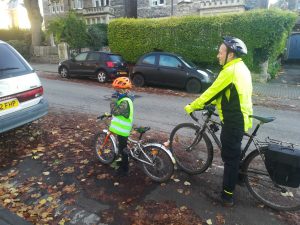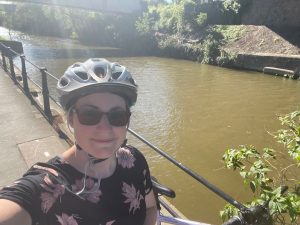This Thursday 4 August is Cycle to Work day. The message is simple – if you commute to work, have a go at cycling all or part of your journey.
We understand that taking up cycling is challenge, which is why our Transport team supports staff and students through initiatives such as our free bike maintenance clinics, cycle to work scheme, free cycle security marking and provision of repair facilities, cycle parking and showers. To inspire more of us to make the shift to a greener commute, we spoke to three colleagues who forgo the car in favour of cycling. Here are their stories:
Marton Balazs, School of Mathematics:

“Cars are a massive burden to individuals and society. The expense and hassle of maintenance, the reduced activity of the owner, and the congestion, pollution, public space, noise… I don’t want to contribute to these problems.
Getting and maintaining the bike, figuring out routes, cycling among cars, and the physical activity itself was easier than I first thought. Once you overcome the initial barrier then getting on your bike for transport becomes second nature.
When it came to choosing my bike, I visited a few bike shops and told them a list of features like comfy bike with dropped handlebar, strong gears, offroad capabilities, mudguard, mirror and dynamo – I was sure such bike didn’t exist. Instead I was told it’s called a touring bike and they showed me a range with the exact specs I was looking for. After doing the maths I was soon in the University’s cycle to work scheme with a Dawes touring bike.
The benefits of cycling are huge – physical activity and the health benefits being the main one. Time saving comes second: commute is not at all slower than driving but it automatically includes the time spent on exercise! Costs come third, the purchase and maintenance of our bikes is a small fraction of what we would spend each year on bus tickets or running a car. As for my young one, he once said “The school run on the bike is the best part of the day!”.
Josie Maskell, School of Physics:
 “I was finding it increasingly stressful and time-consuming driving into work, plus there is limited parking on campus, so it could be a challenge to get a space.
“I was finding it increasingly stressful and time-consuming driving into work, plus there is limited parking on campus, so it could be a challenge to get a space.
A few months ago, I switched to catching the bus or cycling to work. Cycling takes 45-50 minutes, with hills at either end, so I can’t quite manage cycling every day, but I found a lovely route that’s mostly off-road along the river which I really enjoy. Tackling the hills is still hard, and in the beginning, I would walk most of the way but can now cycle the hills with a short rest halfway up, which feels like a major achievement!
I regularly use the University’s cycle clinics to get my bike checked over, and the Ucard bike sheds help me feel more comfortable leaving my bike throughout the day.”
Kate Lippiatt, Financial Services:
 “I ditched my car commute from Nailsea at the start of 2019 and bought an e-bike. I can’t recommend it enough, it’s by far the better option for me. The biggest challenge was just having the courage to give it a go – then I was converted from the first commute! I was a bit nervous about riding in traffic initially, but it only took a couple of rides to feel more confident and I felt a sense of achievement from getting to and from work by bike.
“I ditched my car commute from Nailsea at the start of 2019 and bought an e-bike. I can’t recommend it enough, it’s by far the better option for me. The biggest challenge was just having the courage to give it a go – then I was converted from the first commute! I was a bit nervous about riding in traffic initially, but it only took a couple of rides to feel more confident and I felt a sense of achievement from getting to and from work by bike.
I think it’s important those of us who are able to use active travel do so as often as possible, to help reduce air pollution and carbon emissions and the damaging effects these have on people’s health and the planet. The more people walk, cycle and use public transport, the less time those who need to use their cars will be stuck in traffic.
When it came to choosing my bike, I knew that I wanted an e-bike, as I wasn’t used to cycling more than a few miles and didn’t want to arrive hot and sweaty from cycling up the hill at the end of my journey. I also thought that I wouldn’t want to ride in wet weather, but I bought decent waterproofs and it’s fine. In some ways I prefer riding in the rain as it’s usually when the traffic is worst. Getting a rack and panniers was a good choice for me, as I found carrying everything in a rucksack too heavy.
My top tip to anyone thinking of cycling to work would be to use a website such as Better by Bike to plan your route in advance, as there are often ways you can go by bike that avoid the busiest roads and complicated junctions. I would encourage everyone who can to give it a go – you may well find that you love it and that it’s all round a better commute than driving.”
Thinking of giving cycling a go?
- Test the water and borrow a bike through one of our partners! Read more.
- Join the University’s bicycle user group mailing list for staff and students – sign up here to receive updates about Cycle Clinics and other events , facillities such as showers and parking, and general cycling news.
- Register your ride and have your miles and carbon savings added to the ‘Love to Ride’ UK campaign with free membership to the Love to Ride community.
